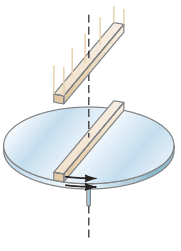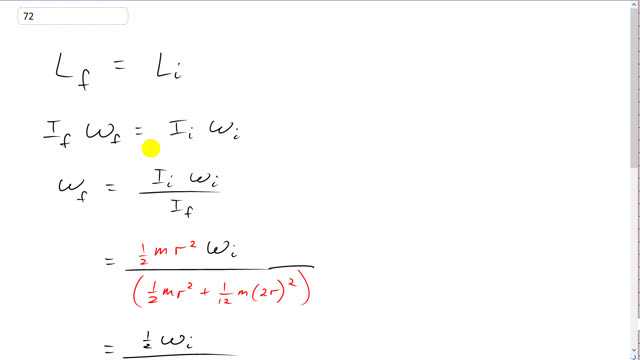
A uniform disk turns at 3.3 rev/s around a frictionless central axis. A nonrotating rod, of the same mass as the disk and length equal to the disk’s diameter, is dropped onto the freely spinning disk, Fig. 8–56. They then turn together around the axis with their centers superposed. What is the angular frequency in rev/s of the combination?


In order to watch this solution you need to have a subscription.
This is Giancoli Answers with Mr. Dychko. Angular momentum is conserved in this question because there's no net torques being exerted—external torques— and so moment of inertia final times the final angular velocity equals moment of inertia initial times the initial angular velocity. and divide both sides by the final moment of inertia and you get that the final angular velocity is I initial ω initial divided by I f. So we have to substitute for these moments of inertia. So initially, there's only the disk and the disk moment of inertia formula is one-half mass times its radius squared and in the final case, we have the disc moment of inertia plus the moment of inertia of the rod that's dropped onto it. So the formula for rod is one-twelfth times mass times the length of the rod squared and in this case, the length of the rod is 2 times the radius of the disk because the rod is the same as the disc diameter. So we'll put in 2r in place of letter l there in that formula for the moment of inertia of a rod. So the mr squared's cancel on the top and bottom and that leaves us with just one-half on the top times ω i divided by one-half plus the 2 squared makes 4, 4 over 12 reduces to 1 over 3 and putting a common denominator on the bottom there, we have 3 over 6 plus 2 over 6 and that makes one-half ω i divided by 5/6 which is the same as one-half ω i times the reciprocal of the denominator 6 over 5 and 6 over 2 is 3 so we have three-fifths ω i is the final angular velocity. So three-fifths times 3.3 revolutions per second gives us about 2.0 revolutions per second after the rod is dropped onto the disk.